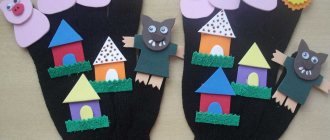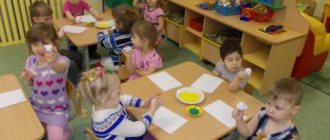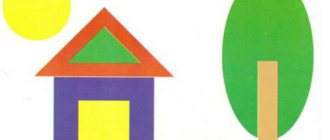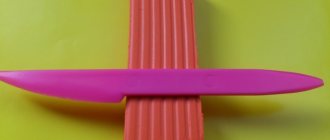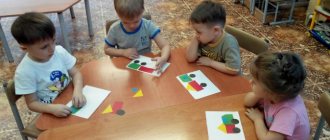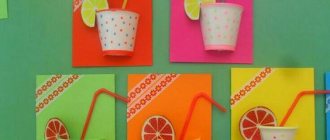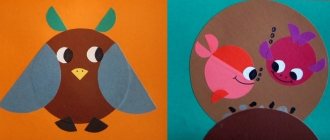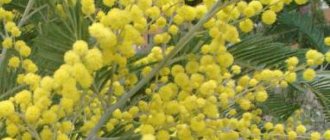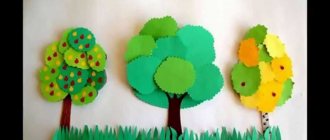DIY “Traffic Light” applique made from paper. Master class with step-by-step photos for children
Master class with step-by-step photos for children 6-8 years old.
Craft “Traffic light” made of paper with origami elements Author: Elena Borisovna Tarazanova, teacher of additional education, Municipal Budgetary Educational Institution of Preparatory Children and Youth Children and Youth “Our Harbor”, Tomsk. Description: Joint activities with your child are a wonderful alternative to computer games and cartoons. Folding origami from paper is a fun and useful activity for both adults and children. This is a wonderful exercise for developing fine motor skills, perseverance, imagination and spatial thinking. After active and noisy games, you can interest and calm the child with the help of a simple craft. The great advantage of paper crafts is the accessibility of this type of creativity. The classes do not require large expenses. Purpose: This master class may be interesting and useful for educators, primary school teachers, additional education teachers, and parents who are passionate about creativity. Can be used for classes at school, kindergarten, summer camp and home leisure. Creative work can be used to conduct integrated lessons with children on traffic rules, as well as to decorate a school office, a group in a kindergarten, a home room, or for participation in exhibitions and competitions. Goal: Mastering the techniques of creating an application with origami elements. Objectives: Educational:
- expand children's knowledge about traffic rules;
- learn to complement the image with details that make the craft more expressive; — learn how to create paper crafts using the origami technique. Developmental:
- develop the ability to work with paper (bend a square sheet of paper in different directions, ironing the folds well);
— develop the ability to work with scissors; - develop fine motor skills of fingers, precision of hand movements, eye; - develop imagination and creative abilities. Educational:
- cultivate accuracy and hard work;
- cultivate interest in creativity. Riddle: At the crossing strip, On the side of the road, A three-eyed, one-legged beast, Of an unknown breed to us, With multi-colored eyes, Talking to us. The red eye looks at us: - Stop! - says his order. The yellow eye looks at us: - Be careful! Stop now! And green: well, go ahead, Pedestrian, to the crossing! This is how the Silent One conducts his conversation... (Traffic light.) Poem: If the red light is on, The traffic light tells us: Stay still!
Do not go! Wait a little. The bright yellow light is on, “Get ready,” it says. The traffic light warns that it is switching the light. He turned on the green light and allowed us the path forward. All the cars are waiting together: Children and mothers are coming. Application "Traffic light" made of paper with origami elements
Necessary materials: Colored paper, black cardboard, scissors, glue pencil, felt-tip pens, eraser, pencil, templates, product sample, illustrations, poems, riddles.
Make a traffic light template yourself or you can print it from the Internet in any shape you wish.
Take black cardboard. On the reverse side, trace the traffic light template along the contour.
Cut out the traffic light part.
To make white circles, take three squares of white paper.
Place a circle template on the aligned squares.
Trace the circle template.
Cut out the details.
It turned out to be three circles.
Glue 3 white circles onto the traffic light part.
To make the dog head part, take a square of paper and bend it diagonally.
Fold the resulting part in half again.
In the resulting triangle, the upper corners need to be bent down, departing the same distance from the middle (fold line).
The ears can be folded back further and made long, or left small and protruding.
Make 3 dog parts of different colors - red, yellow, green.
Draw and cut out 6 circles for the eyes from white paper.
Glue on the eye details for each dog.
Look carefully at how the smile is drawn in accordance with the color of the emoticon.
Draw faces in accordance with the traffic light signal. The red dog has a stern look (you cannot cross the road).
The green dog has a kind look (you can safely cross the roadway).
Yellow color warns that the color of the traffic light will change.
Glue the parts of the dogs in a certain order. The application is ready. Creative success! (The poem and riddle were taken from Internet sites)
We recommend watching:
DIY traffic light applique for older children. DIY paper applique for kindergarten. Traffic light Construction from waste material. Traffic light. Master class for children 5-6 years old DIY “Traffic light” application for children of the senior preparatory group
Similar articles:
Traffic light - do-it-yourself tablet. Master Class
Traffic light from a plastic bottle
This fabulous option is very easy. Let's turn on our imagination. We will need:
- Plastic bottle
- Brushes and paints (preferably gouache)
- Colored paper
- PVA glue
- Scissors
Work progress:
- We choose a plastic bottle, it is better to take the one with a longer neck.
- We paint it a neutral color (meaning not red, not yellow, not green). Let it dry.
- Next, we cut out circles from colored paper for the traffic light itself and details for our fairy-tale character. These are eyes, mouth, nose, ears, hands.
- The bottle is dry. Carefully glue the finished parts and, of course, the circles, making sure that the distance between them is the same.
- But our hero cannot be without hair! We also make hair from paper. Cut into thin strips and twist with scissors.
- We also make the cap out of paper. And look what happened. To fully complete our hero, we will add a rod or a road sign to the handles.
Materials from which you can make a traffic light
To make crafts, various textured materials are used. The main thing is that they are safe for children.
Use:
- cardboard;
- colored paper;
- computer disks;
- plastic bags;
- paper towel rolls;
- plastic jars and bottles;
- plasticine;
- plywood;
- yarn;
- natural material.
The great thing about the material is that it can be dyed red, yellow and green if required.
